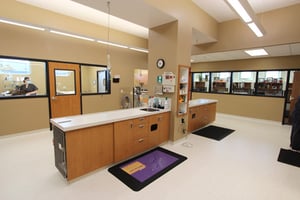The landscape of healthcare design necessitates a thorough comprehension of the specific regulations in the industry. Since millwork is an integral part of healthcare facilities, designers and builders must be aware of the standards and codes that ensure patient safety, privacy, and accessibility. Let's discuss the important healthcare design guidelines and their impact on custom millwork solutions.
Adhering to Infection Control Standards
The control of infection spread is a critical concern in medical facilities. Regulations concerning materials, surfaces, and construction practices are strictly enforced to minimize the risk of contamination.
Non-Porous and Easy-to-Clean Surfaces
Health care millwork must use non-porous, bacterial and viral resistant materials. Laminates and solid surfaces are often preferred for their ease of cleaning and disinfection. The use of these materials is crucial when designing millwork components such as cabinetry and counters to meet infection control requirements.
Seamless Construction
Millwork elements must not contain any openings or joints that could conceal or spread pathogens. The use of certain types of adhesives and joining techniques is commonly employed in regulations to create seamless construction, which results in smooth, ductile surfaces.
Ensuring Patient Privacy
Patient privacy is an essential aspect of healthcare and laws and regulations, such as the Health Insurance Portability and Accountability Act (HIPAA), are a crucial consideration in this regard. To ensure confidentiality, millwork design must incorporate materials and structures that help to maintain privacy.
Sound-Absorbing Panels and Partitions
Sound-absorbing materials can be used to reduce transmission of sound from consultation areas, waiting rooms and treatment spaces in custom millwork. Not only does this improve patient privacy, it also brings more peace to the room.
Supporting Accessibility
The Americans with Disabilities Act (ADA) is a regulatory framework that ensures accessibility for all patients, regardless of their ability to access healthcare services. Millwork must be made accessible to individuals with disabilities, ensuring equal access to healthcare. For example, millwork designs must take into account the height and reach of counters, shelves, and storage units for patients who use wheelchairs. Fixed installations may require a specific height specification, or the installation may be adjustable.
Fire Safety and Hazardous Materials Storage
Healthcare regulations place a significant emphasis on fire safety when it comes to selecting millwork materials and designs. To prevent accidents and ensure the safety of patients and staff, storage solutions for hazardous materials, such as medical waste or cleaning supplies, must also meet strict guidelines.
Conclusion
Navigating healthcare regulations in design is a complex but essential aspect of creating safe, functional, and welcoming healthcare environments. If designers and fabricators are familiar with the codes and practices, custom millwork provides a versatile solution that can meet these demanding specifications while helping to provide a comfortable healing and working environment.
Topics: healthcare, regulations

_706%20(1).png?width=543&height=200&name=Akron%20Childrens%20Hospital%20-%20Medical-1(1)_706%20(1).png)




.png?width=203&height=142&name=IFA%20Member%20Logo%20EPS%20(1).png)
.png%20for%20web.png?width=203&height=94&name=2022_VetFran_Logo%20(002).png%20for%20web.png)
.png?width=203&height=150&name=ICSC-logo-tag-full-color%20(1).png)